Nanocasting of Periodic Mesoporous Materials as an Effective Strategy to Prepare Mixed Phases of Titania
Abstract
:1. Introduction
2. Results and Discussion
2.1. Physico-Chemical Characterization
2.1.1. Powder X-ray Diffraction (XRD)
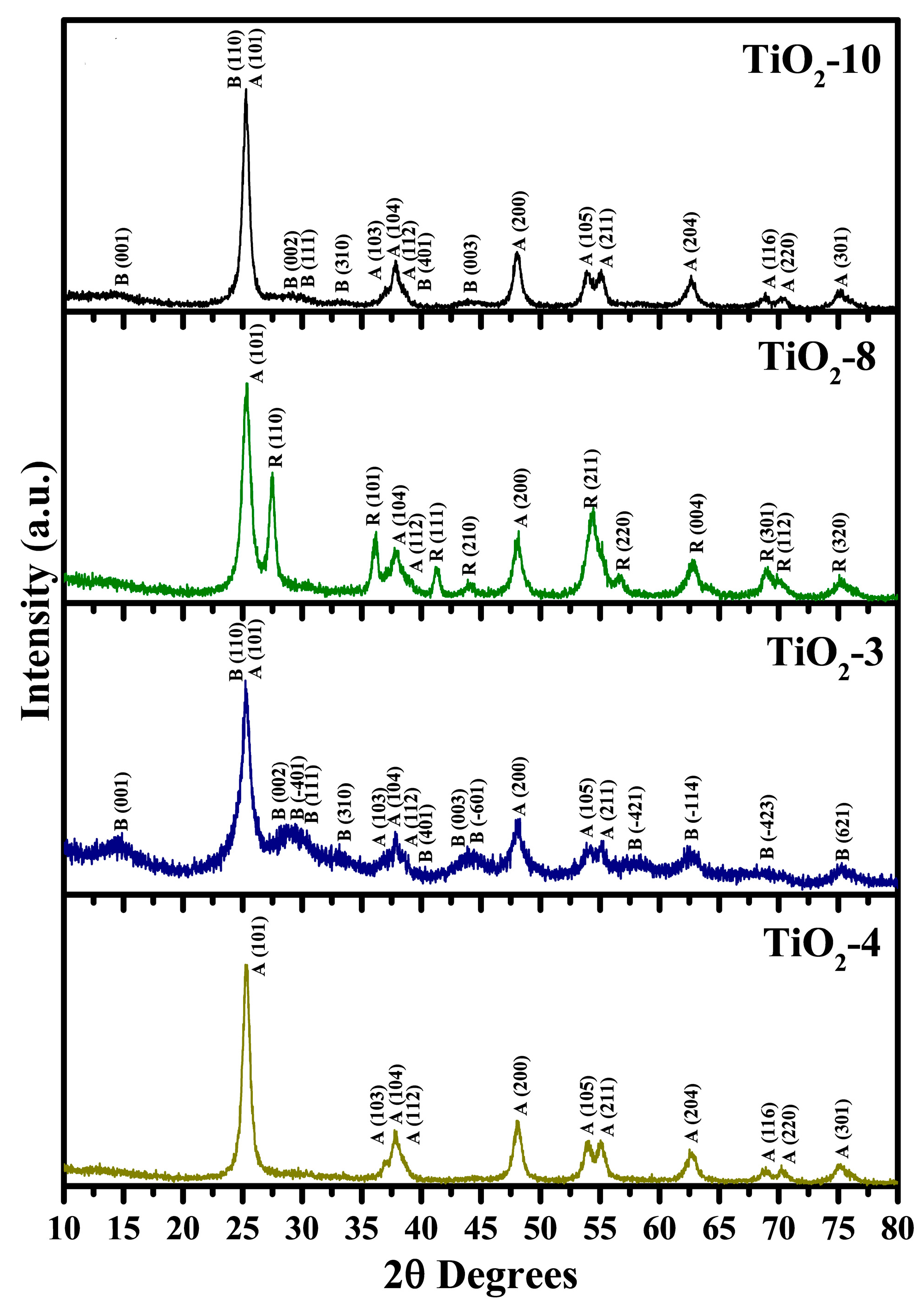
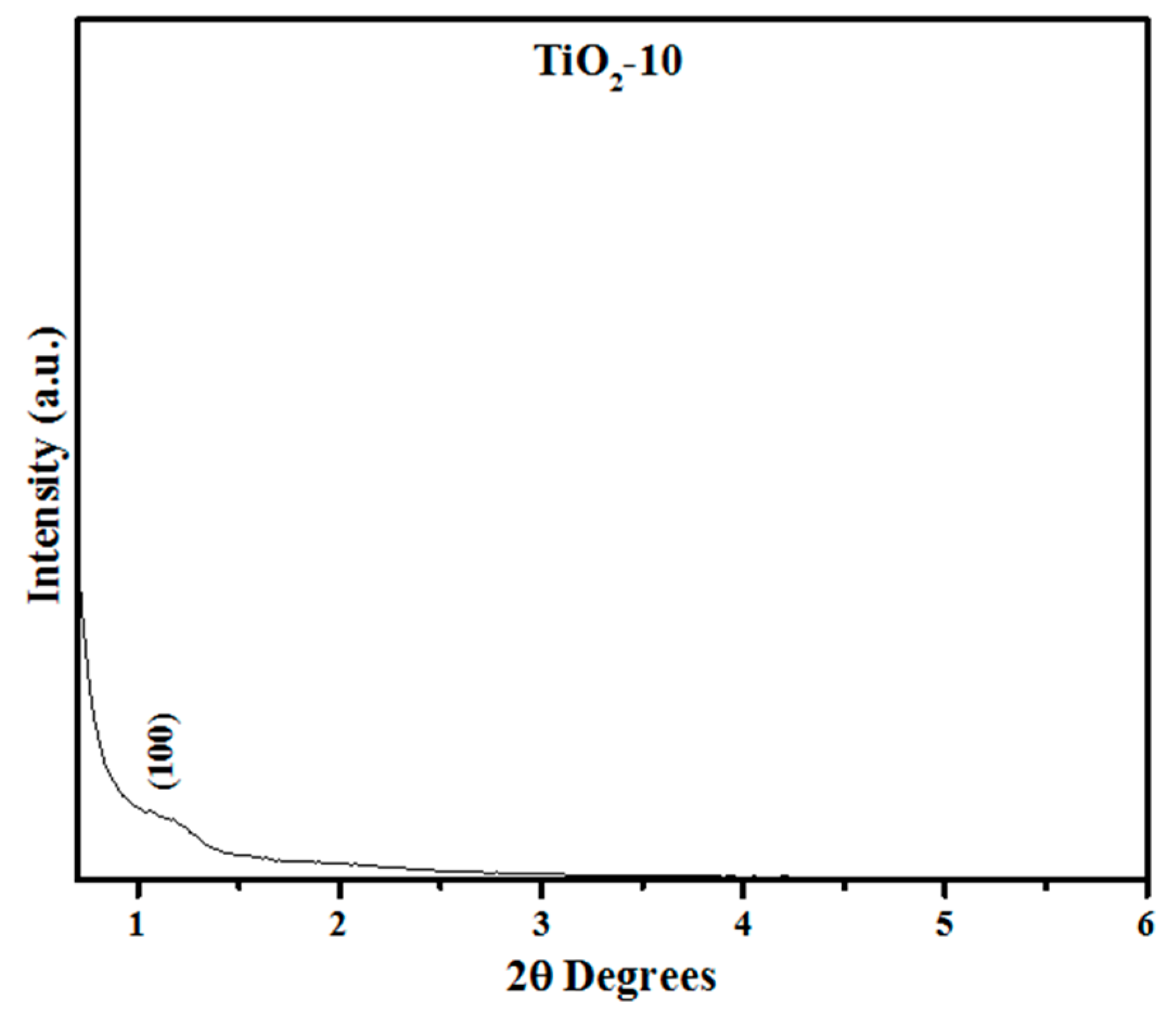
| Material | Phase(s) (%) a | Crystallite Size (s) (Å) b | Bandgap (eV) c | ||||
|---|---|---|---|---|---|---|---|
| Anatase | TiO2(B) | Rutile | Anatase | TiO2(B) | Rutile | ||
| TiO2-3 | 48 | 52 | - | 68 | 17 | - | 3.35 |
| TiO2-8 | 75 | - | 25 | 78 | - | 101 | 3.02 |
| TiO2-10 | 98 | 2 | - | 104 | 207 | - | 3.18 |
| TiO2-4 | 100 | - | - | 93 | - | - | 3.20 |
2.1.2. N2 Physisorption
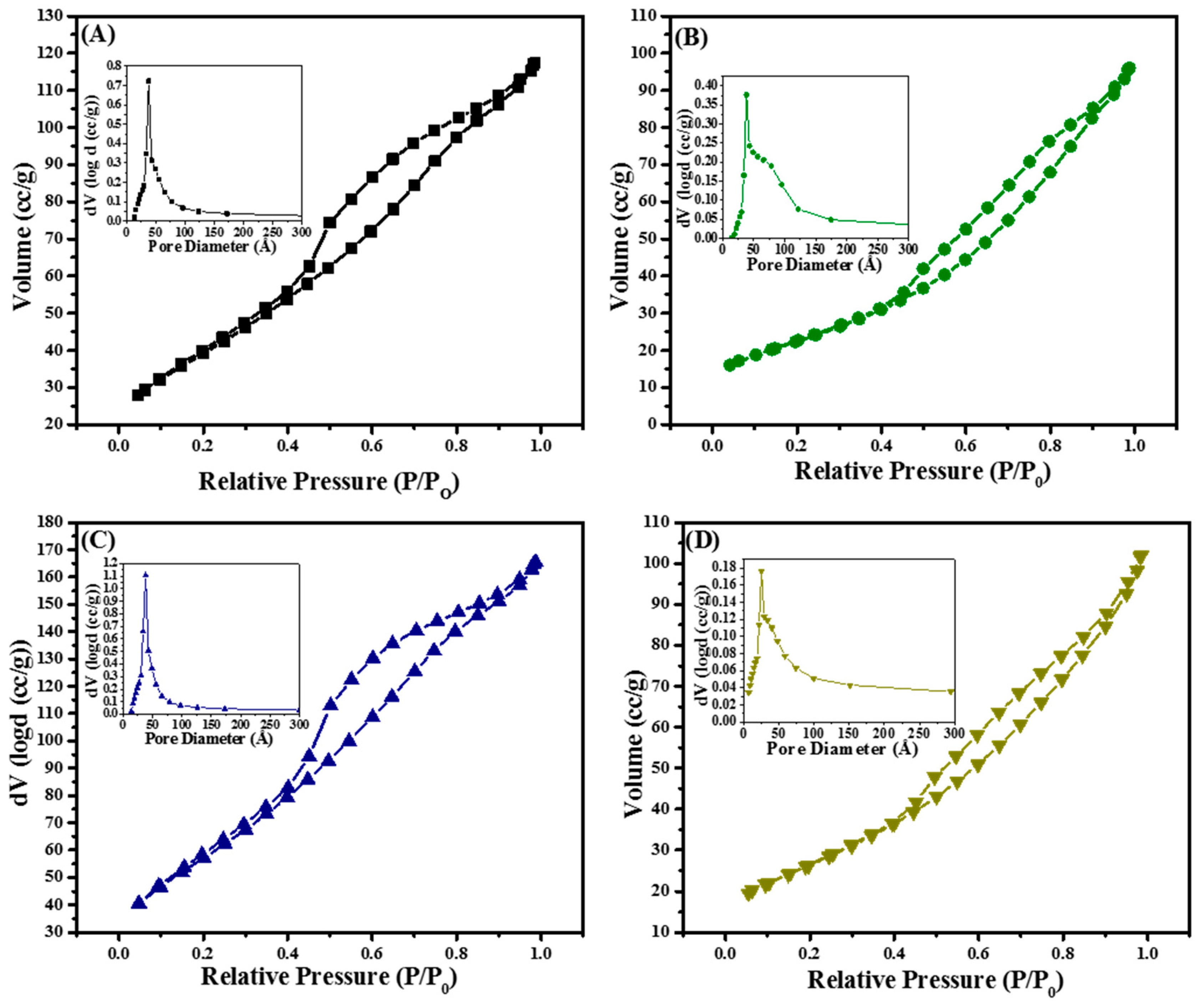
| Material | Specific Surface Area (m2/g) a | Pore Volume (cc/g) b | Average Pore Diameter (Å) |
|---|---|---|---|
| TiO2-10 | 146 | 0.18 | 50 |
| TiO2-8 | 83 | 0.15 | 72 |
| TiO2-3 | 212 | 0.26 | 48 |
| TiO2-4 | 97 | 0.16 | 65 |
2.1.3. Diffuse Reflectance Spectroscopy
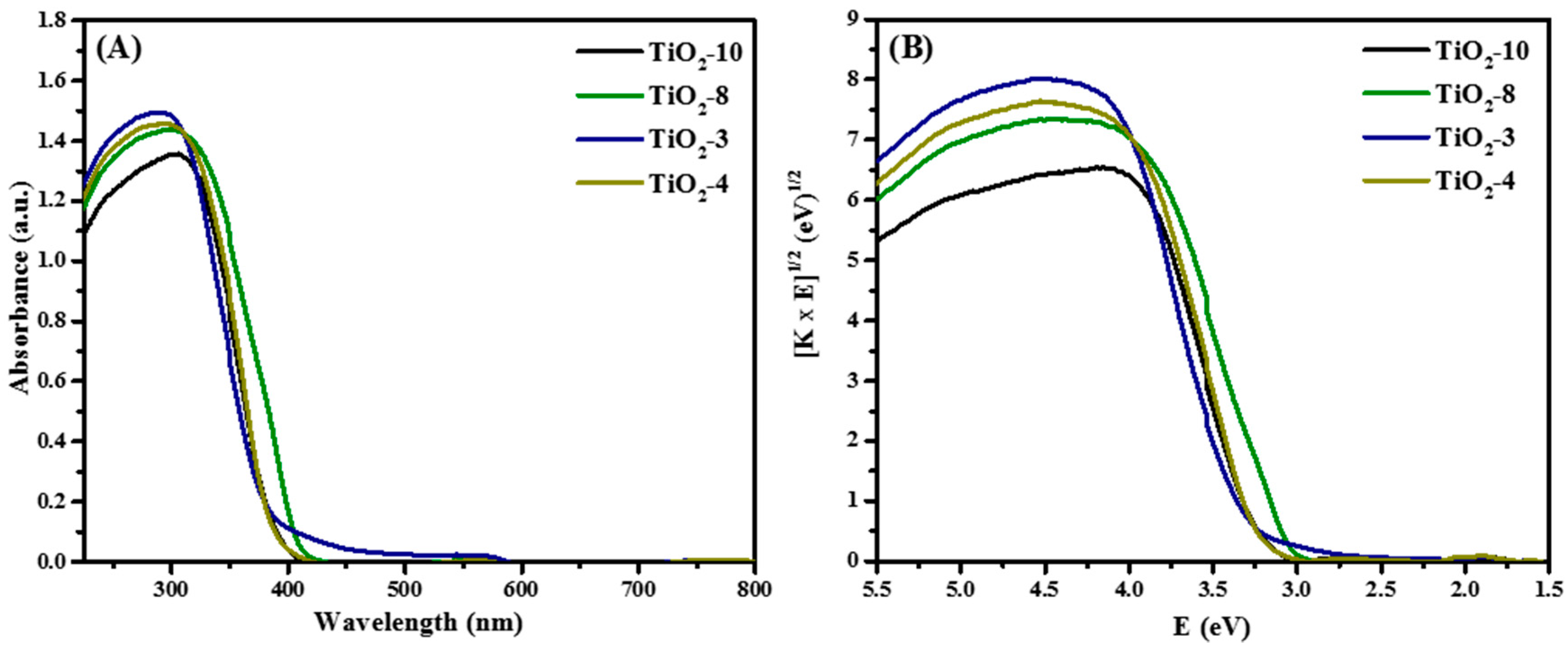
2.1.4. Transmission Electron Microscopy
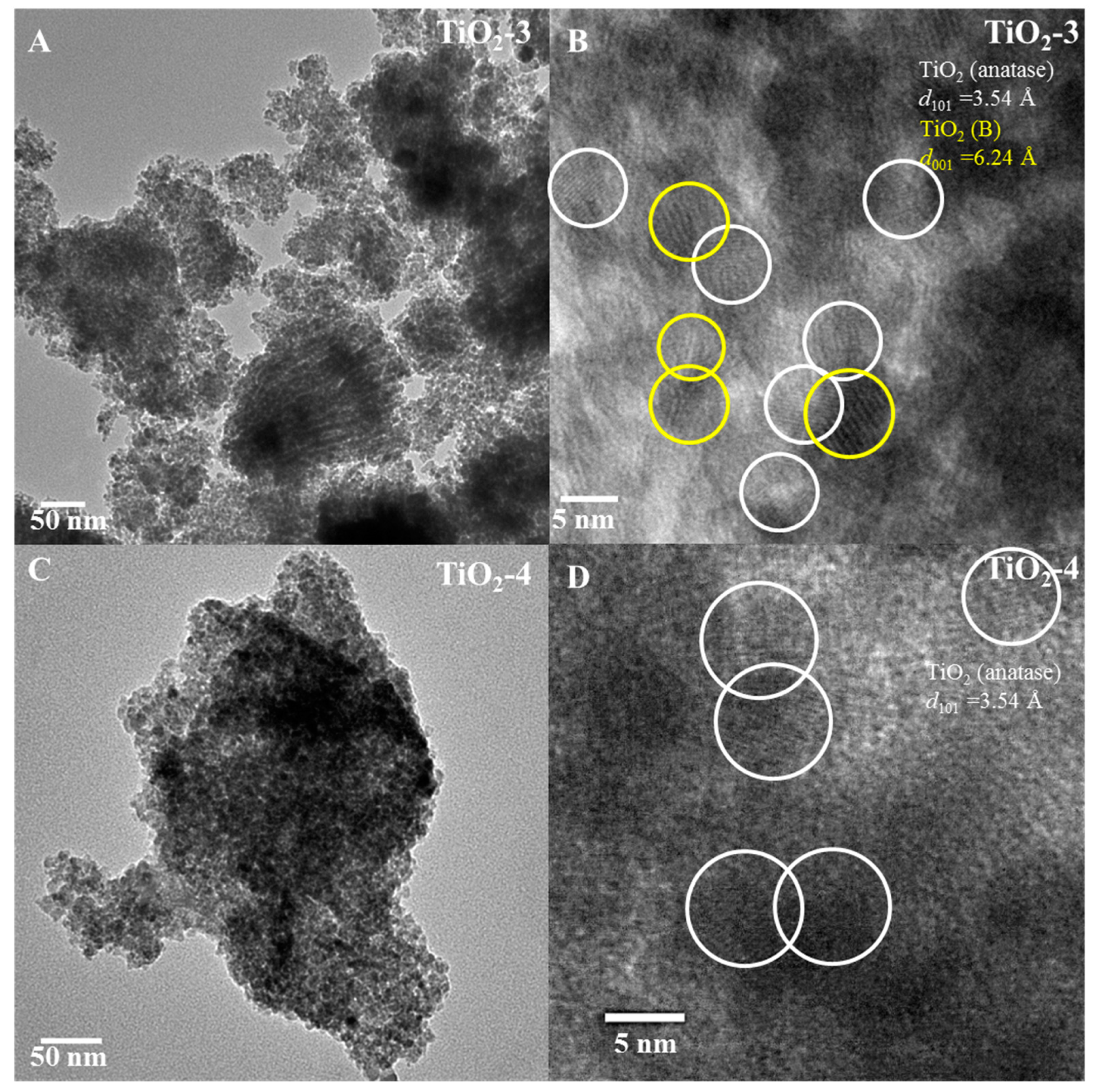

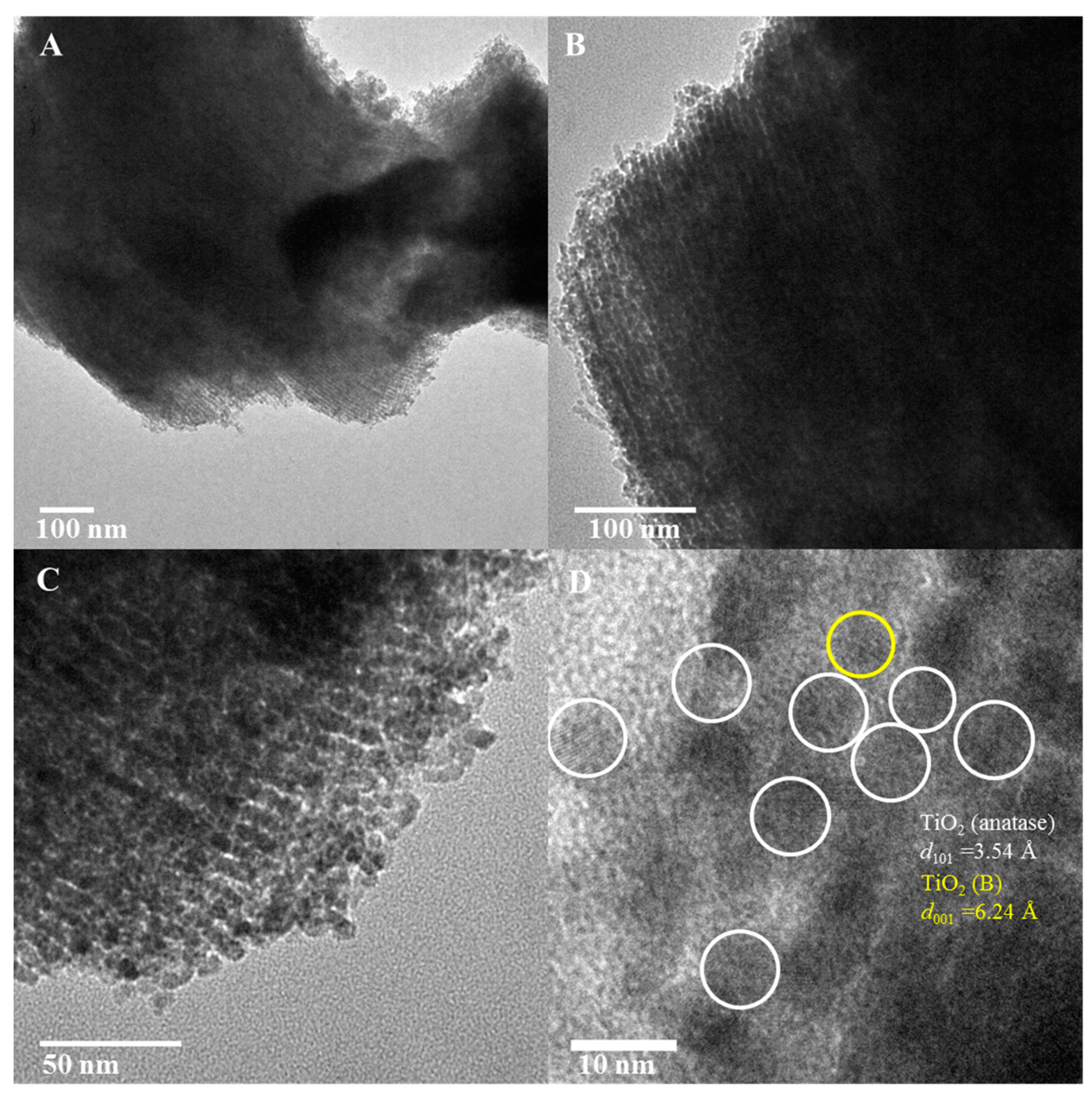
2.1.5. Scanning Electron Microscopy
2.2. Solar Hydrogen Evolution
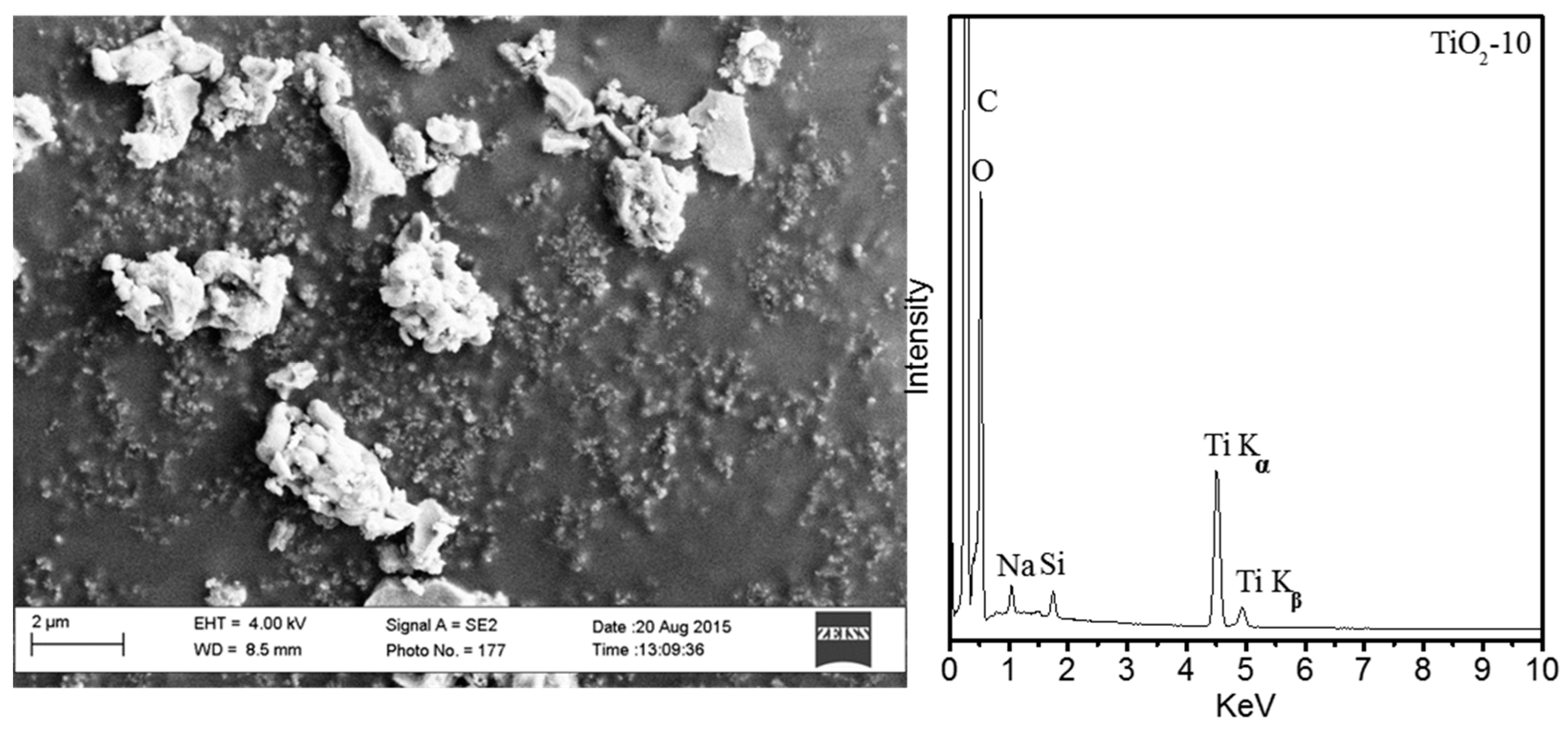

2.3. Photoluminescence
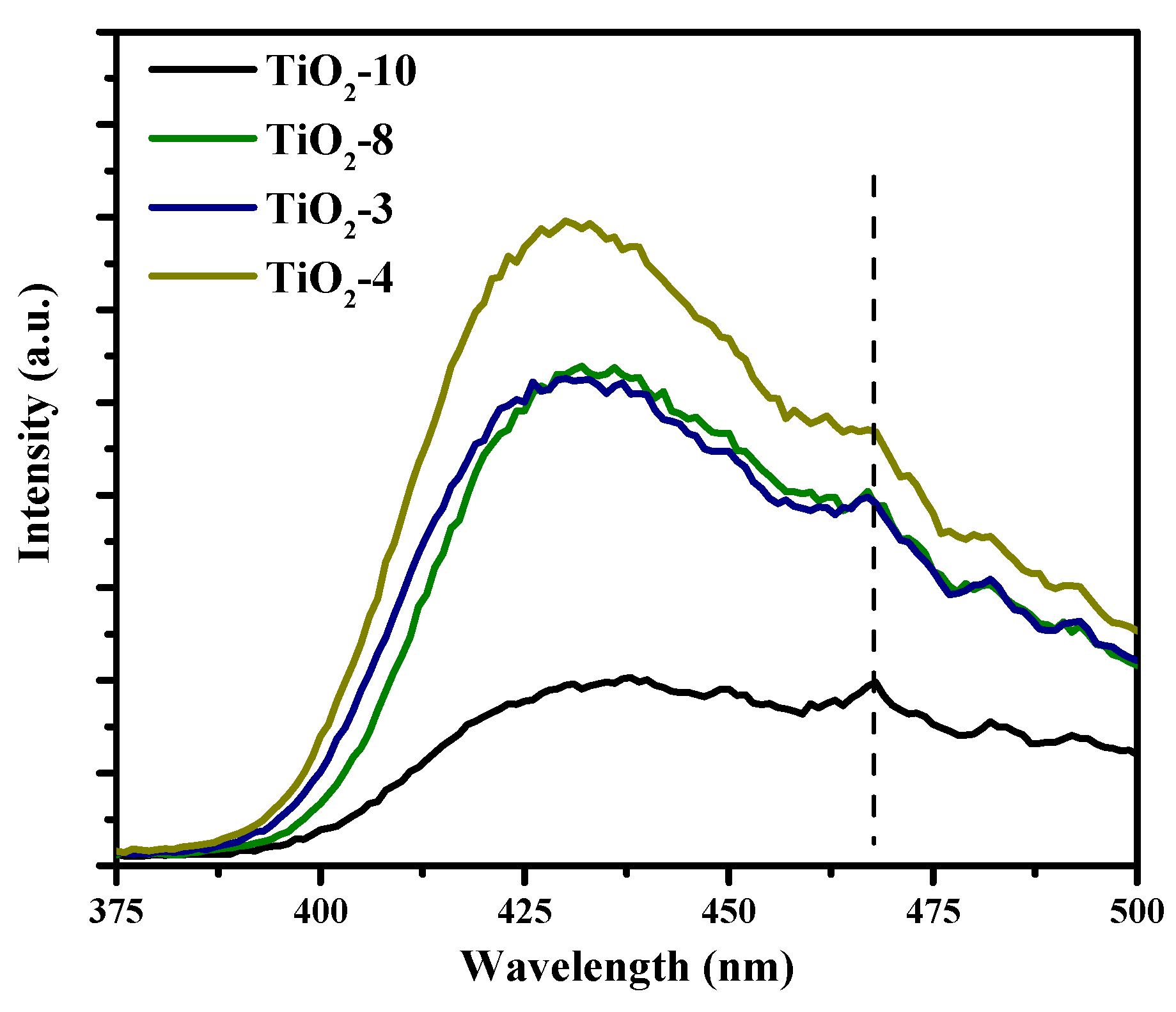
3. Materials and Methods
3.1. Materials
3.2. Synthesis
3.3. Characterization and Photocatalytic Studies
4. Conclusions
Supplementary Materials
Acknowledgments
Author Contributions
Conflicts of Interest
References
- Chen, X.; Mao, S.S. Titanium dioxide nanomaterials: Synthesis, properties, modifications, and applications. Chem. Rev. 2007, 107, 2891–2959. [Google Scholar] [PubMed]
- Sang, L.; Zhao, Y.; Burda, C. TiO2 nanoparticles as functional building blocks. Chem. Rev. 2014, 114, 9283–9318. [Google Scholar] [CrossRef] [PubMed]
- Bai, J.; Zhou, B. Titanium dioxide nanomaterials for sensor applications. Chem. Rev. 2014, 114, 10131–10176. [Google Scholar] [CrossRef] [PubMed]
- Bai, Y.; Mora-Seró, I.; de Angelis, F.; Bisquert, J.; Wang, P. Titanium dioxide nanomaterials for photovoltaic applications. Chem. Rev. 2014, 114, 10095–10130. [Google Scholar] [CrossRef] [PubMed]
- Ma, Y.; Wang, X.; Jia, Y.; Chen, X.; Han, H.; Li, C. Titanium dioxide-based nanomaterials for photocatalytic fuel generations. Chem. Rev. 2014, 114, 9987–10043. [Google Scholar] [CrossRef] [PubMed]
- Schneider, J.; Matsuoka, M.; Takeuchi, M.; Zhang, J.; Horiuchi, Y.; Anpo, M.; Bahnemann, D.W. Understanding TiO2 photocatalysis: Mechanisms and materials. Chem. Rev. 2014, 114, 9919–9986. [Google Scholar] [CrossRef] [PubMed]
- Di Yao, D.; Field, M.R.; O’Mullane, A.P.; Kalantar-zadeh, K.; Ou, J.Z. Electrochromic properties of TiO2 nanotubes coated with electrodeposited MoO3. Nanoscale 2013, 5, 10353–10359. [Google Scholar] [CrossRef] [PubMed] [Green Version]
- Pearson, A.; Jani, H.; Kalantar-zadeh, K.; Bhargava, S.K.; Bansal, V. Gold nanoparticle-decorated keggin ions/TiO2 photococatalyst for improved solar light photocatalysis. Langmuir 2011, 27, 6661–6667. [Google Scholar] [CrossRef] [PubMed]
- Laranjo, M.T.; Ricardi, N.C.; Arenas, L.T.; Benvenutti, E.V.; de Oliveira, M.C.; Santos, M.J.L.; Costa, T.M.H. TiO2 and TiO2/SiO2 nanoparticles obtained by sol-gel method and applied on dye sensitized solar cells. J. Sol-Gel. Sci. Technol. 2014, 72, 273–281. [Google Scholar] [CrossRef]
- Cheng, W.-Y.; Deka, J.R.; Chiang, Y.-C.; Rogeau, A.; Lu, S.-Y. One-step, surfactant-free hydrothermal method for syntheses of mesoporous TiO2 nanoparticle aggregates and their applications in high efficiency dye-sensitized solar cells. Chem. Mater. 2012, 24, 3255–3262. [Google Scholar] [CrossRef]
- Pietron, J.J.; Rolison, D.R. Improving the efficiency of titania aerogel-based photovoltaic electrodes by electrochemically grafting isopropyl moieties on the titania surface. J. Non-Cryst. Solids 2004, 350, 107–112. [Google Scholar] [CrossRef]
- Pietron, J.J.; Stux, A.M.; Compton, R.S.; Rolison, D.R. Dye-sensitized titania aerogels as photovoltaic electrodes for electrochemical solar cells. Sol. Energ. Mater. Sol. C 2007, 91, 1066–1074. [Google Scholar] [CrossRef]
- Chiang, Y.-C.; Cheng, W.-Y.; Lu, S.-Y. Titania aerogels as a superior mesoporous structure for photoanodes of dye-sensitized solar cells. Int. J. Electrochem. Sci. 2012, 7, 6910–6919. [Google Scholar]
- Iwai, Y.; Nakashima, T.; Yonezawa, S. Preparation of dye sensitized solar cell by using supercritical carbon dioxide drying. J. Supercrit. Fluids 2013, 77, 153–157. [Google Scholar] [CrossRef]
- Gu, Z.-Y.; Gao, X.-D.; Li, X.-M.; Jiang, Z.-W.; Huang, Y.-D. Nanoporous TiO2 aerogel blocking layer with enhanced efficiency for dye-sensitized solar cells. J. Alloys Compd. 2014, 590, 33–40. [Google Scholar]
- Parayil, S.K.; Psota, R.J.; Koodali, R.T. Modulating the textural properties and photocatalytic hydrogen production activity of TiO2 by high temperature supercritical drying. Int. J. Hydrogen Energy 2013, 38, 10215–10225. [Google Scholar] [CrossRef]
- Kong, Y.; Shen, X.-D.; Cui, S. Direct synthesis of anatase TiO2 aerogel resistant to high temperature under supercritical ethanol. Mater. Lett. 2014, 117, 192–194. [Google Scholar] [CrossRef]
- Rasalingam, S.; Wu, C.-M.; Koodali, R.T. Modulation of pore sizes of titanium dioxide photocatalysts by a facile template free hydrothermal synthesis method: Implications for photocatalytic degradation of rhodamine b. ACS Appl. Mater. Interfaces 2015, 7, 4368–4380. [Google Scholar] [CrossRef] [PubMed]
- Thapa, A.; Zai, J.; Elbohy, H.; Poudel, P.; Adhikari, N.; Qian, X.; Qiao, Q. TiO2 coated urchin-like SnO2 microspheres for efficient dye-sensitized solar cells. Nano Res. 2014, 7, 1–10. [Google Scholar] [CrossRef]
- Chou, T.P.; Zhang, Q.; Russo, B.; Fryxell, G.E.; Cao, G. Titania particle size effect on the overall performance of dye-sensitized solar cells. J. Phys. Chem. C 2007, 111, 6296–6302. [Google Scholar] [CrossRef]
- Soler-Illia, G.J.A.A.; Sanchez, C.; Lebeau, B.; Patarin, J. Chemical strategies to design textured materials: From microporous and mesoporous oxides to nanonetworks and hierarchical structures. Chem. Rev. 2002, 102, 4093–4138. [Google Scholar] [CrossRef] [PubMed]
- Soler-Illia, G.J.A.A.; Louis, A.; Sanchez, C. Synthesis and characterization of mesostructured titania-based materials through evaporation-induced self-assembly. Chem. Mater. 2002, 14, 750–759. [Google Scholar] [CrossRef]
- Grosso, D.; Cagnol, F.; Soler-Illia, G.; Crepaldi, E.; Amenitsch, H.; Brunet-Bruneau, A.; Bourgeois, A.; Sanchez, C. Fundamentals of mesostructuring through evaporation-induced self-assembly. Adv. Funct. Mater. 2004, 14, 309–322. [Google Scholar] [CrossRef]
- Shen, P.-S.; Tai, Y.-C.; Chen, P.; Wu, Y.-C. Clean and time-effective synthesis of anatase TiO2 nanocrystalline by microwave-assisted solvothermal method for dye-sensitized solar cells. J. Power Sources 2014, 247, 444–451. [Google Scholar] [CrossRef]
- Wang, X.; Tian, J.; Fei, C.; Lv, L.; Wang, Y.; Cao, G. Rapid construction of TiO2 aggregates using microwave assisted synthesis and its application for dye-sensitized solar cells. RSC Adv. 2015, 5, 8622–8629. [Google Scholar] [CrossRef]
- Zhao, Z.; Liu, G.; Li, B.; Guo, L.; Fei, C.; Wang, Y.; Lv, L.; Liu, X.; Tian, J.; Cao, G. Dye-sensitized solar cells based on hierarchically structured porous TiO2 filled with nanoparticles. J. Mater. Chem. A 2015, 3, 11320–11329. [Google Scholar] [CrossRef]
- Zhao, L.; Yu, J. Controlled synthesis of highly dispersed TiO2 nanoparticles using SBA-15 as hard template. J. Colloid Interface Sci. 2006, 304, 84–91. [Google Scholar] [CrossRef] [PubMed]
- Lee, D.-W.; Park, S.-J.; Ihm, S.-K.; Lee, K.-H. Synthesis of bimodal mesoporous titania with high thermal stability via replication of citric acid-templated mesoporous silica. Chem. Mater. 2007, 19, 937–941. [Google Scholar] [CrossRef]
- Kim, S.S.; Lee, H.I.; Shon, J.K.; Hur, J.Y.; Kang, M.S.; Park, S.S.; Kong, S.S.; Yu, J.A.; Seo, M.; Li, D.; et al. Preparation of highly ordered mesoporous TiO2 materials with crystalline framework from different mesostructured silica templates via nanoreplication. Chem. Lett. 2008, 37, 140–141. [Google Scholar] [CrossRef]
- Hwang, K.-J.; Yoo, S.-J.; Kim, S.-S.; Kim, J.-M.; Shim, W.-G.; Kim, S.-I.; Lee, J.-W. Photovoltaic performance of nanoporous TiO2 replicas synthesized from mesoporous materials for dye-sensitized solar cells. J. Nanosci. Nanotechnol. 2008, 8, 4976–4981. [Google Scholar] [CrossRef] [PubMed]
- Yue, W.; Xu, X.; Irvine, J.T.S.; Attidekou, P.S.; Liu, C.; He, H.; Zhao, D.; Zhou, W. Mesoporous monocrystalline TiO2 and its solid-state electrochemical properties. Chem. Mater. 2009, 21, 2540–2546. [Google Scholar] [CrossRef]
- Yue, W.; Randorn, C.; Attidekou, P.S.; Su, Z.; Irvine, J.T.S.; Zhou, W. Syntheses, Li insertion, and photoactivity of mesoporous crystalline TiO2. Adv. Funct. Mater. 2009, 19, 2826–2833. [Google Scholar] [CrossRef]
- Ren, Y.; Hardwick, L.J.; Bruce, P.G. Lithium intercalation into mesoporous anatase with an ordered 3D pore structure. Angew. Chem. Int. Ed. 2010, 49, 2570–2574. [Google Scholar] [CrossRef] [PubMed]
- Zhang, Z.; Zuo, F.; Feng, P. Hard template synthesis of crystalline mesoporous anatase TiO2 for photocatalytic hydrogen evolution. J. Mater. Chem. 2010, 20, 2206–2212. [Google Scholar] [CrossRef]
- Hwang, K.-J.; Shim, W.-G.; Jung, S.-H.; Yoo, S.-J.; Lee, J.-W. Analysis of adsorption properties of N719 dye molecules on nanoporous TiO2 surface for dye-sensitized solar cell. Appl. Surface Sci. 2010, 256, 5428–5433. [Google Scholar] [CrossRef]
- Shopsowitz, K.E.; Stahl, A.; Hamad, W.Y.; MacLachlan, M.J. Hard templating of nanocrystalline titanium dioxide with chiral nematic ordering. Angew. Chem. Int. Ed. 2012, 51, 6886–6890. [Google Scholar] [CrossRef] [PubMed]
- Jin, M.; Park, J.-N.; Shon, J.; Li, Z.; Lee, E.; Kim, J. Highly ordered crystalline mesoporous metal oxides for hydrogen peroxide decomposition. J. Porous Mater. 2013, 20, 989–995. [Google Scholar] [CrossRef]
- Serrano, D.P.; Calleja, G.; Pizarro, P.; Gálvez, P. Enhanced photocatalytic hydrogen production by improving the Pt dispersion over mesostructured TiO2. Int. J. Hydrogen Energy 2014, 39, 4812–4819. [Google Scholar] [CrossRef]
- Kusior, A.; Warchal, A.; Komornicki, S.; Radecka, M. Hard-template synthesis of titanium dioxide hollow spheres. Micro Nano Lett. 2014, 9, 721–725. [Google Scholar] [CrossRef]
- Lee, K.J.; Bak, W.; Kim, J.-J.; Snyder, M.A.; Yoo, W.C.; Sung, Y.-E. How pore parameters affect Li ion depletion in mesoporous materials for lithium-ion batteries. J. Phys. Chem. C 2015, 119, 7604–7613. [Google Scholar] [CrossRef]
- Mahoney, L.; Koodali, R. Versatility of evaporation-induced self-assembly (EISA) method for preparation of mesoporous TiO2 for energy and environmental applications. Materials 2014, 7, 2697–2746. [Google Scholar] [CrossRef]
- Luther, M.; Shivatharsiny, R.; Chia-Ming, W.; Rui, P.; Ranjit, T.K. Aging dependent phase transformation of mesostructured titanium dioxide nanomaterials prepared by evaporation-induced self-assembly process: Implications for solar hydrogen production. AIMS Mater. Sci. 2015, 2, 230–242. [Google Scholar]
- Kho, Y.K.; Iwase, A.; Teoh, W.Y.; Mӓdler, L.; Kudo, A.; Amal, R. Photocatalytic H2 evolution over TiO2 nanoparticles. The synergistic effect of anatase and rutile. J. Phys. Chem. C 2010, 114, 2821–2829. [Google Scholar] [CrossRef]
- Andronic, L.; Perniu, D.; Duta, A. Synergistic effect between TiO2 sol-gel and Degussa P25 in dye photodegradation. J. Sol-Gel. Sci. Technol. 2013, 66, 472–480. [Google Scholar] [CrossRef]
- Li, G.; Dimitrijevic, N.M.; Chen, L.; Nichols, J.M.; Rajh, T.; Gray, K.A. The important role of tetrahedral ti4+ sites in the phase transformation and photocatalytic activity of TiO2 nanocomposites. J. Am. Chem. Soc. 2008, 130, 5402–5403. [Google Scholar] [CrossRef] [PubMed]
- You, X.; Chen, F.; Zhang, J. Effects of calcination on the physical and photocatalytic properties of TiO2 powders prepared by sol–gel template method. J. Sol-Gel. Sci. Technol. 2005, 34, 181–187. [Google Scholar] [CrossRef]
- Chen, L.; Yao, B.; Cao, Y.; Fan, K. Synthesis of well-ordered mesoporous titania with tunable phase content and high photoactivity. J. Phys. Chem. C 2007, 111, 11849–11853. [Google Scholar] [CrossRef]
- Dai, S.; Wu, Y.; Sakai, T.; Du, Z.; Sakai, H.; Abe, M. Preparation of highly crystalline TiO2 nanostructures by acid-assisted hydrothermal treatment of hexagonal-structured nanocrystalline titania/cetyltrimethyammonium bromide nanoskeleton. Nanoscale Res. Lett. 2010, 5, 1829–1835. [Google Scholar] [CrossRef] [PubMed]
- Yan, M.; Chen, F.; Zhang, J.; Anpo, M. Preparation of controllable crystalline titania and study on the photocatalytic properties. J. Phys. Chem. B 2005, 109, 8673–8678. [Google Scholar] [CrossRef] [PubMed]
- Teleki, A.; Pratsinis, S.E.; Kalyanasundaram, K.; Gouma, P.I. Sensing of organic vapors by flame-made TiO2 nanoparticles. Sens. Actuators B Chem. 2006, 119, 683–690. [Google Scholar] [CrossRef]
- Meyer, S.; Gorges, R.; Kreisel, G. Preparation and characterisation of titanium dioxide films for catalytic applications generated by anodic spark deposition. Thin Solid Films 2004, 450, 276–281. [Google Scholar] [CrossRef]
- Sing, K.S.W.; Everett, D.H.; Haul, R.A.W.; Moscou, L.; Pierotti, R.A.; Rouquerol, J.; Siemieniewska, T. Reporting physisorption data for gas/solid systems—With special reference to the determination of surface area and porosity. Pure Appl. Chem. 1985, 57, 603–619. [Google Scholar] [CrossRef]
- Kruk, M.; Jaroniec, M. Gas adsorption characterization of ordered organic-inorganic nanocomposite materials. Chem. Mater. 2001, 13, 3169–3183. [Google Scholar] [CrossRef]
- Peng, R.; Baltrusaitis, J.; Wu, C.M.; Koodali, R.T. Pd-Ti-MCM-48 cubic mesoporous materials for solar simulated hydrogen evolution. Int. J. Hydrogen Energy 2015, 40, 905–918. [Google Scholar] [CrossRef]
- Wu, C.M.; Rathi, M.; Ahrenkiel, S.P.; Koodali, R.T.; Wang, Z.Q. Facile synthesis of MOF-5 confined in SBA-15 hybrid material with enhanced hydrostability. Chem. Comm. 2013, 49, 1223–1225. [Google Scholar] [CrossRef] [PubMed]
- Sample Availability: Samples of the mesoporous materials are available from the authors.
© 2015 by the authors. Licensee MDPI, Basel, Switzerland. This article is an open access article distributed under the terms and conditions of the Creative Commons by Attribution (CC-BY) license ( http://creativecommons.org/licenses/by/4.0/).
Share and Cite
Mahoney, L.; Rasalingam, S.; Wu, C.-M.; Koodali, R.T. Nanocasting of Periodic Mesoporous Materials as an Effective Strategy to Prepare Mixed Phases of Titania. Molecules 2015, 20, 21881-21895. https://doi.org/10.3390/molecules201219812
Mahoney L, Rasalingam S, Wu C-M, Koodali RT. Nanocasting of Periodic Mesoporous Materials as an Effective Strategy to Prepare Mixed Phases of Titania. Molecules. 2015; 20(12):21881-21895. https://doi.org/10.3390/molecules201219812
Chicago/Turabian StyleMahoney, Luther, Shivatharsiny Rasalingam, Chia-Ming Wu, and Ranjit T. Koodali. 2015. "Nanocasting of Periodic Mesoporous Materials as an Effective Strategy to Prepare Mixed Phases of Titania" Molecules 20, no. 12: 21881-21895. https://doi.org/10.3390/molecules201219812





